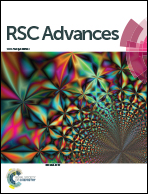High-performance dielectric thin film nanocomposites of barium titanate and cyanoethyl pullulan: controlling the barium titanate nanoparticle size using a sol–gel method
Abstract
A monodispersed BaTiO3 nanoparticle sol was prepared by a sol–gel method, and the sizes of the obtained nanoparticles were successfully controlled from 15 to 60 nm by controlling the amount of H2O introduced for the hydrolysis reaction. Cyanoethyl pullulan (CEP) was added to the BaTiO3 sol to prepare a nanocomposite ink of BaTiO3 and CEP. A thin film was fabricated by spin-coating the ink on a Pt/Ti/SiO2/Si wafer. The device obtained from the 30 nm BaTiO3/CEP nanocomposite ink demonstrated the highest dielectric constant, about 50 at 1 kHz, during the particle size range from 15 to 60 nm. The temperature dependence of the dielectric constant at approximately 120 °C is eliminated using our BaTiO3 nanoparticles, because of their cubic crystal structure, which does not show a transformation at 120 °C. These improvements of the dielectric properties are important for the development of thin film-type capacitors for compact electric devices.


 Please wait while we load your content...
Please wait while we load your content...